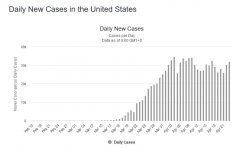IdahoMtnSpyder
Well-known member
At least that's the way I see it. For 3 weeks now the daily new cases in all of the US is staying almost flat, hardly declining. Some states may see declines to low levels but it sure doesn't look like the US as a whole will for several months. See here: https://www.worldometers.info/coronavirus/country/us/

You can see daily case graphs for each of the states on the John Hopkins site: https://coronavirus.jhu.edu/map.html. Click on the Admin 1 tab under the list of countries and Daily Cases tab under the graph. A number of states are still seeing daily increases in the daily new cases number. No state is coming close to a zero daily number yet.

You can see daily case graphs for each of the states on the John Hopkins site: https://coronavirus.jhu.edu/map.html. Click on the Admin 1 tab under the list of countries and Daily Cases tab under the graph. A number of states are still seeing daily increases in the daily new cases number. No state is coming close to a zero daily number yet.
